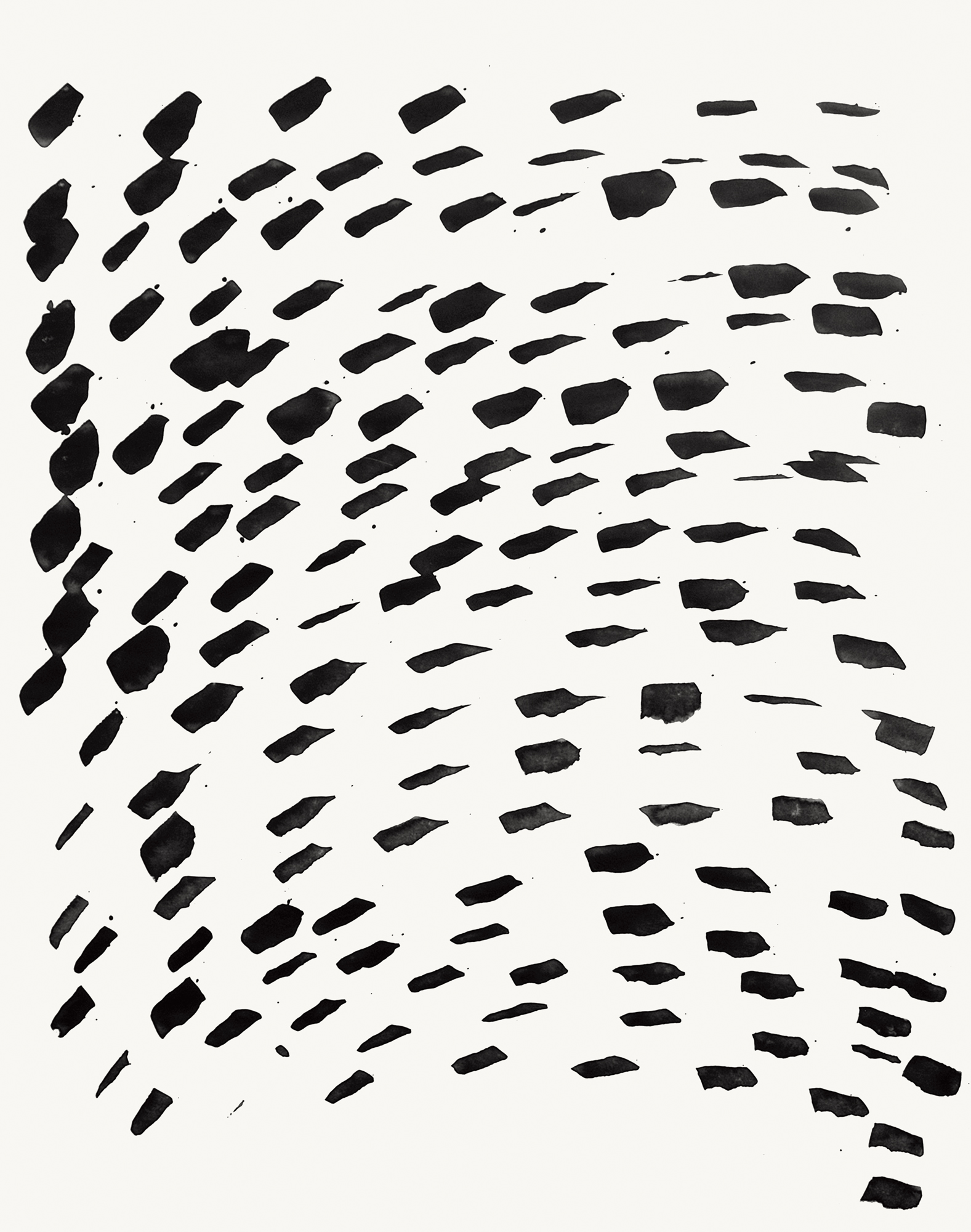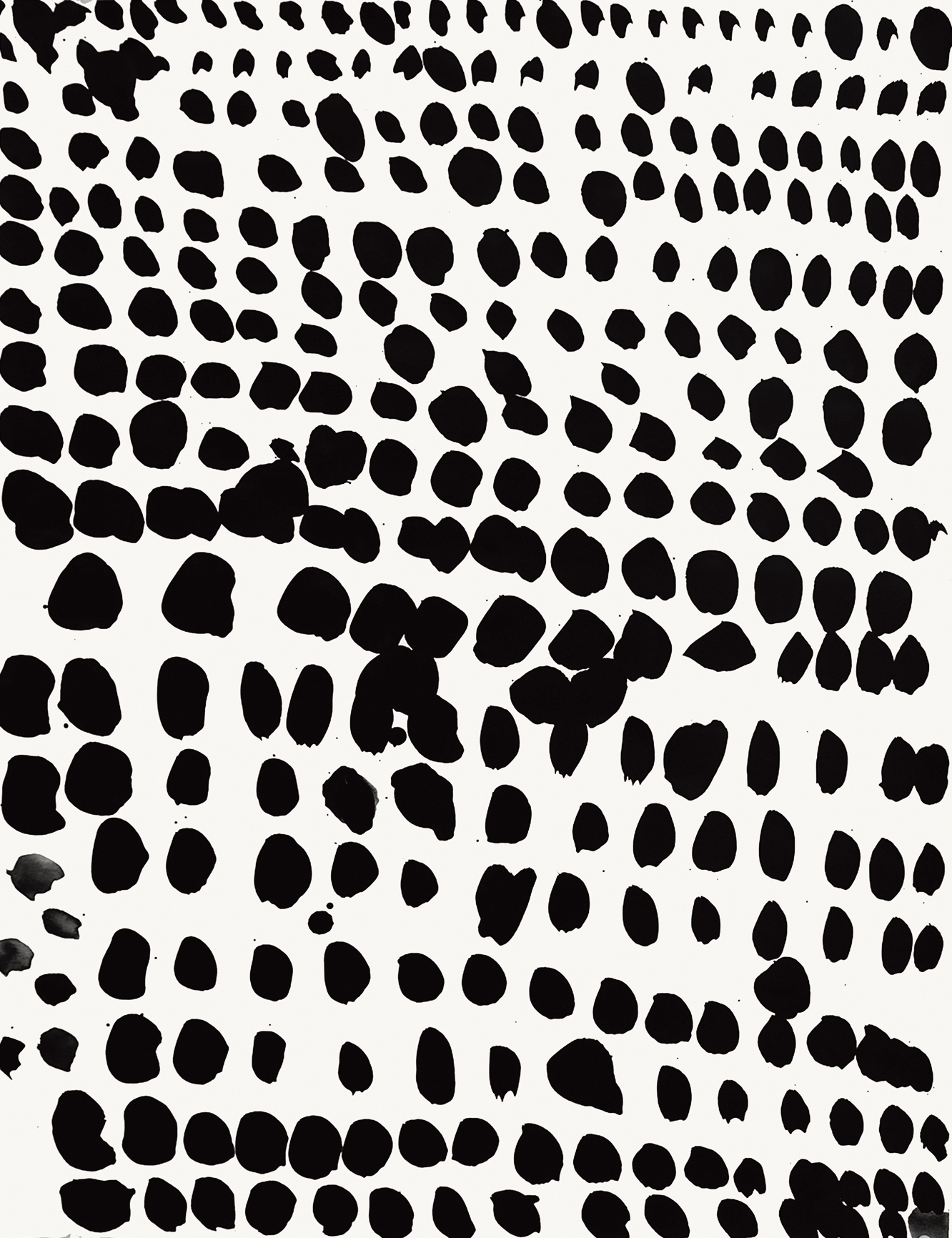Pierrette Bloch comes from a family with Swiss roots. Born in 1928 in Paris, where she still lives and works to this day, she is one of the most renowned French artists of postwar abstraction. She studied art in the studios of André Lhote and Henri Goetz, and, in the 1950s, began to develop a personal vocabulary of great purity that was to evolve through a number of elements, drawing, spots, lines, the space of the sheet of paper and the time of the gesture.
Punctuated by the repetition of minimalist forms like the dot and line, and characterised by the use of poor materials like paper, hardboard, ink and horsehair, her singular, unclassifiable work stretches over a period of more than fifty years and embraces a range of techniques (painting, drawing, collage, and installation). Her ink landscapes are walks that take shape through the obstinacy of a fluid gesture and the constancy of a black pigment that regularly partitions the sheet of paper into a fragmented musical score, like an abstract form of writing the secret of which the artist alone holds.
Along with her graphic output, Bloch has designed installations since the 1970s using horsehair thread, shifting her two-dimensional graphic style into space and exploring the connections between full volumes and voids, shadow and light. These delicate, twisting sculptures, linear compositions comprising a multitude of tangled, knotted rough threads, project a fragile shadow of irregular punctuations, extending the teeming dance of her ink-on-paper works. In 1993, they inspired the artist to create her first thin paper lines. Stretching out from one to twelve metres in length, they offer new possibilities of spatial expansion to her spontaneous and uninterrupted mark. In its sensorial minimalism, the art of Pierrette Bloch has been providing the outlines of a deeply embodied poetics of gesture and repetition.
Although rather personal for quite a long time, her world and the coherence of her approach have opened the way to international renown. Shown in prestigious museums around the world, her work hangs in numerous private and public collections, including MoMA in New York, the Yokohama Museum of Art in Japan, the Stedelijk Museum in Amsterdam, and the Fondation Maeght in Saint-Paul-de-Vence, as well as the Centre Georges Pompidou and the Musée d’art moderne de la Ville de Paris.
Punctuated by the repetition of minimalist forms like the dot and line, and characterised by the use of poor materials like paper, hardboard, ink and horsehair, her singular, unclassifiable work stretches over a period of more than fifty years and embraces a range of techniques (painting, drawing, collage, and installation). Her ink landscapes are walks that take shape through the obstinacy of a fluid gesture and the constancy of a black pigment that regularly partitions the sheet of paper into a fragmented musical score, like an abstract form of writing the secret of which the artist alone holds.
Along with her graphic output, Bloch has designed installations since the 1970s using horsehair thread, shifting her two-dimensional graphic style into space and exploring the connections between full volumes and voids, shadow and light. These delicate, twisting sculptures, linear compositions comprising a multitude of tangled, knotted rough threads, project a fragile shadow of irregular punctuations, extending the teeming dance of her ink-on-paper works. In 1993, they inspired the artist to create her first thin paper lines. Stretching out from one to twelve metres in length, they offer new possibilities of spatial expansion to her spontaneous and uninterrupted mark. In its sensorial minimalism, the art of Pierrette Bloch has been providing the outlines of a deeply embodied poetics of gesture and repetition.
Although rather personal for quite a long time, her world and the coherence of her approach have opened the way to international renown. Shown in prestigious museums around the world, her work hangs in numerous private and public collections, including MoMA in New York, the Yokohama Museum of Art in Japan, the Stedelijk Museum in Amsterdam, and the Fondation Maeght in Saint-Paul-de-Vence, as well as the Centre Georges Pompidou and the Musée d’art moderne de la Ville de Paris.

